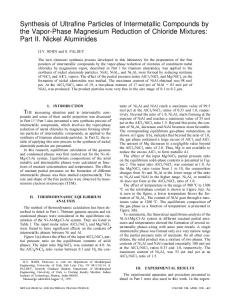The influence of the reactant size on the micropyretic synthesis of NiAl intermetallic compounds
- PDF / 1,288,046 Bytes
- 10 Pages / 576 x 792 pts Page_size
- 77 Downloads / 331 Views
The effect of the nickel (Ni) and aluminum (Al) reactant particle size on the micropyretic synthesis of NiAl is studied in this article. A change in the low melting component (A1 particle) size is noted to have a limited influence on the micropyretic synthesis conditions. However, a change in the high melting component (Ni particle) size not only influences the combustion temperature and propagation velocity, but also affects the final porosity and grain size of the synthesized products. The combustion mode is also noted to change from stable to unstable when the Ni particle size is increased. It is noted that a diffusion-type control mechanism is dominant for the rapid reaction sequence in the NiAl system. An atomistic mechanism of the Ni-A1 micropyretic reaction is also proposed in this article. Following this model, analytical expressions are developed to relate the variation of the Ni size to the NiAl formation rate with the imposed processing conditions during the micropyretic synthesis. The mechanism of the final grain formation and the grain size changes with changes in the processing variables is also discussed.
1. INTRODUCTION
The kinetics of synthesis of all powder metallurgical reactions including micropyretic/combustion synthesis are often dependent on the initial dispersion of the reactants and the particle sizes.'-' In solid-solid combustion reactions, it has been shown that both the diffusion and capillary-controlled combustion are significantly dependent on the particle size of the melting reactants.].' It is now recognized that the combustion rate is diffusioncontrolled in systems with a small size of the low melting component,',' whereas capillary spreading is rate controlling in systems with a larger size of the low melting component. It has also been reported that the particle size influences not only the propagation velocity5 of the combustion front, but also the uniformity and physical properties of the products formed.j-" Several studies have been directed at analyzing the influence of the low melting reactant size on the propagation velocity and combustibility during micropyretic synthesis. Rice et U L . ~have studied the effect of reactant sizes on the combustion synthesis of the Ti-B and Ti-C systems and have shown that the ignition temperature and combustion velocity are a function of the size of the Ti particle. In the Ti-C system, it was reported that green compacts with larger Ti particles (-35 mesh,
Data Loading...











